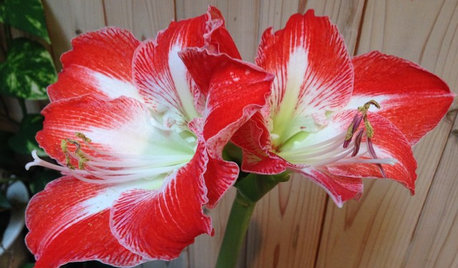buzzing dimmed bulbs
Jamie
11 years ago
Related Stories

HOME TECHHere's a Bright Idea: Smart Bulbs for Better Lighting
Lightbulbs that can change brightness and color with a cell phone command show flashes of design brilliance
Full Story
HOUSEPLANTSHow to Force Amaryllis Bulbs Indoors
Enjoy vibrant red blossoms even as gardens turn snowy white, by teaching this hardy repeat performer to ignore the calendar
Full Story
LIGHTINGRecessed Lighting 101
Looking to brighten a drab, dim space? Recessed lighting may be your answer. Here's what you need to know
Full Story
DECORATING GUIDESLighting That Invites Romance
Dim the lights and turn on the tunes. On Valentine’s Day it’s all about setting the mood
Full Story
BATHROOM DESIGNLight-Up Mirrors Offer Bright Design Solutions
If you're taking a dim view of a problem bathroom area, try the flash of design brilliance that is the electric mirror
Full Story
WINTER GARDENINGHow to Get an Amaryllis to Rebloom
Enjoy glorious flowers year after year just when you need them most, with this step-by-step strategy
Full Story
LIGHTINGBask in Lamplight's Comfort This Season
Get pro insight on lamp styles, shades and ever-confusing bulbs to enjoy the benefits of lamplight on long, cold nights
Full Story
COLORWant Gorgeous Interior Colors? Look to the Light
See how to manipulate natural and artificial light — and learn about those baffling new bulbs — to get the exact room colors you want
Full Story
SHOP HOUZZShop Houzz: Industrial Lighting for Every Room
Details like exposed bulbs, pipes and metal cages set off our bestselling industrial lights
Full Story
KITCHEN DESIGNThe Ecofriendly Kitchen: Light Your Kitchen Right
Harnessing the daylight is a terrific choice for earth-friendly kitchens, but it's not the only one
Full Story








alan_s_thefirst
Ron Natalie
Related Professionals
Concord Electricians · Salem General Contractors · Bryn Mawr-Skyway General Contractors · Cheney General Contractors · Country Club Hills General Contractors · Ken Caryl General Contractors · Pinewood General Contractors · Renton General Contractors · Spanaway General Contractors · Summit General Contractors · Waxahachie General Contractors · Muscoy Solar Energy Systems · Emeryville Solar Energy Systems · Fayetteville Home Automation & Home Media · New York City Home Automation & Home Mediahomebound
brickeyee
greg_2010
brickeyee
JamieOriginal Author
ionized_gw
yosemitebill
Ron Natalie
yosemitebill
Ron Natalie
yosemitebill
brickeyee
JamieOriginal Author
brickeyee